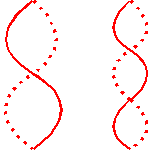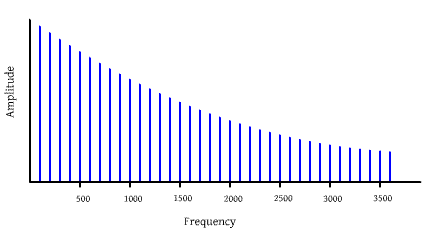
Consider again the waves produced by the bass clarinet and the flute. The lines in these spectra look suspiciously evenly-spaced. This is a typical property of naturally occurring waves.
Consider a guitar string. It can vibrate in a simple back-and-forth motion:

But it can also vibrate in more complex ways, where each half or third of the string is moving in the opposite direction from its neighbours:

To see tacky animated graphics of these modes of vibration, click: first mode, second mode, third mode.
Naturally occurring waves in a guitar string involve all three kinds of vibration simultaneously, and an infinite number of others.
Each mode of vibration produces a simple wave with its own frequency and amplitude:
The spectrum of the wave produced by the guitar string would look like:

The wave produced by the vibration of the vocal cords also has this kind of structure. The wave produced by the vocal cords (before it is modified by the vocal tract) is often called the glottal wave. The fundamental frequency (the frequency of the lowest simple wave) is perceived as the pitch.